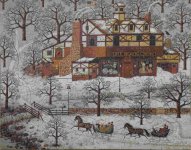OK, you need a single light source, pointing straight at the puzzle from one side, very low down so that it skims across the surface. A diffused light source is essential and
a softbox is your best choice. The softbox should be no smaller than the long side of the puzzle. This will produce the best effect, showing the joints as well as they can be shown, but will also emphasise any faults.
The light source (which fits inside the softbox) should ideally be flash, but a
photographic LED will do the job - a non-photographic one will produce distorted colours. All this requires enough space to set it up.
Then you need to consider the Inverse Square Law - the intensity of light falls off over distance, at a high rate when the distance is close. Because of this the light source (softbox) needs to be a long way away from the nearest part of the subject because the furthest part will be even further away and so will receive less light. You haven't told us the size of the puzzles so we can't do the simple calculations for you, but as an example, if the puzzle is 1m x1m and the light source is just 1 m away, then the light has to travel 1 m to the nearest part and 2m to the furthest point, which will reduce the light on the furthest part to just 1/4 of the light on the closest part. Obviously, that won't be good enough. Move the light twice as far away and the light falloff will be reduced to half, which would still be far more than most people would find acceptable - so, can you increase the light distance to say 4m or 8m? That's why I asked you about space.
If you don't have enough indoor space then you could shoot it outside, in complete darkness of course, but there may be practical challenges.
It seems to me that as the jigsaws have the benefit of being made of thick wood then you need to show this benefit. That's why I suggested that you include a shot with a piece removed, to show that, or alternatively you could just put a piece from another puzzle on top, which would do the same job but with more drama.
Once you have done this you can use your software solutions, but getting a decent photo as a starting point isn't optional.
Hope this helps.



